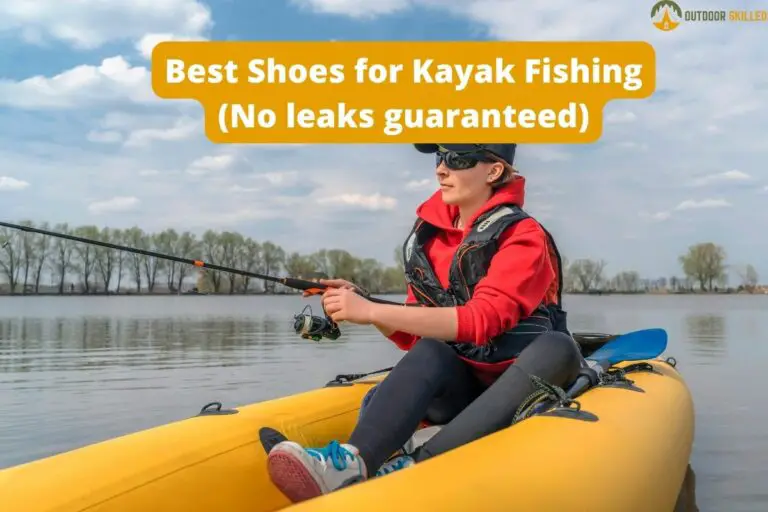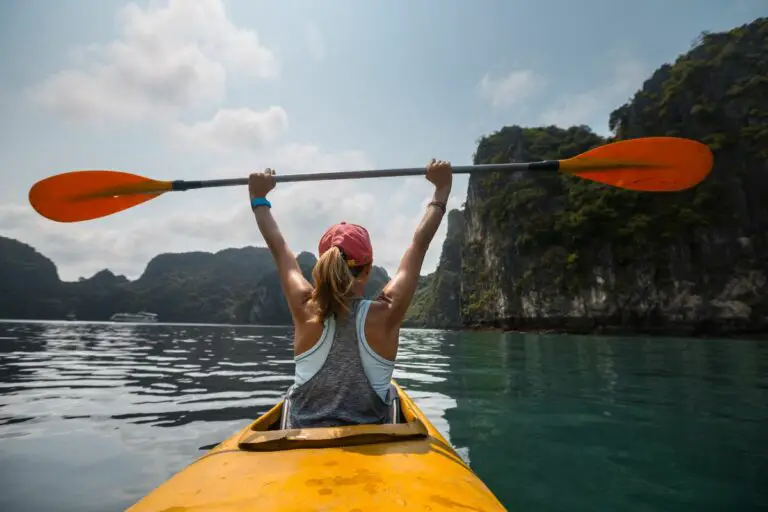Is Kayaking Worth It? Only for Those People…
Kayaking is a popular outdoor activity that has many benefits, as it allows individuals to relax and explore the beauty of nature while also getting a good workout.
However, as with any activity, kayaking also has its downsides, including potential risks and high expenses. So, is kayaking worth it despite these downsides?
Kayaking is worth it for its various physical and mental health benefits. However, it’s still important to be aware of all the downsides and potential risks of kayaking, so you can plan your kayaking trip accordingly and take the necessary precautions to improve your experience.
Keep reading to learn more about the pros and cons of kayaking and what you can do to make the most of your kayaking experience.
Table of Contents
The Pros and Cons of Kayaking

Like any activity, kayaking has its benefits and downsides, and it’s important for kayakers, especially beginners, to be aware of both and weigh them against each other.
So, let’s break down the pros and cons of kayaking in detail to help you decide whether kayaking is the right activity for you.
The Pros of Kayaking
- Improved physical fitness: Kayaking provides a full-body workout, which can help to improve cardiovascular health, strength, and endurance. It is a low-impact exercise that is easy on the joints, making it a great option for people of all ages and fitness levels. If you are going Kayaking regularly, it can also help build muscles.
- Mental relaxation and stress relief: Kayaking allows you to disconnect from the stresses of daily life and focus on the present moment. Being out on the water can be calming and help to reduce anxiety and stress.
- Connection with nature: Kayaking allows you to immerse yourself in nature and experience the beauty of the great outdoors. It can help to foster a deeper appreciation for the natural world and inspire a desire to protect and conserve it.
- Exploration and adventure: Kayaking allows you to explore new places and discover hidden gems that may not be accessible by land. It can provide a sense of adventure and excitement that is hard to replicate in other activities.
- Socialization: Kayaking can be a great way to connect with others who share a love for the outdoors. It can be enjoyed alone, with a partner, or in a group, making it a versatile activity that can be adapted to fit any social situation.
The Cons of Kayaking
- High expense: Kayaking can be expensive, especially if you’re purchasing your own instead of renting. Kayaks, paddles, and other gear can be costly, and you may also need to pay for transportation and storage of your equipment.
- Risk of injury: Kayaking can be dangerous, especially if proper safety precautions are not taken. Common injuries include bruises, cuts, strains, sprains, and even drowning.
- Physical demand: Kayaking can be physically demanding as it requires a certain level of physical fitness, so it can be challenging for those who are not used to upper-body strength exercises.
- Weather conditions: Kayaking is dependent on weather conditions, and rough waters or windy weather can make kayaking dangerous or impossible.
- Environmental impact: Like any outdoor activity, kayaking can have a negative impact on the environment. Kayakers should be aware of the potential impact of their activity on local wildlife, vegetation, and water quality.
Another con for kayaking is that most people end up disposing of their old kayaks in a way that’s not very environmentally friendly, but did you know you can give your kayak a second life with purpose? Learn why donating your kayak is the best option here where I also discuss what organizations should you consider for donations.
The Potential Risks of Kayaking
As mentioned before, there are certain risks you may face while kayaking, especially if you do not take proper safety precautions. You need to be aware of these risks to learn how to overcome them.
So, here are some of the potential risks of kayaking:
- Drowning: This is perhaps the most serious risk associated with kayaking. If a kayaker that can’t swim falls out of their kayak and is not wearing a life jacket, they can quickly become submerged and drown.
- Capsizing: Kayaks can tip over if they are not paddled correctly or if they encounter waves, rapids, or other challenging conditions. This can result in injury or even drowning, particularly if the kayaker is not able to exit the kayak quickly enough.
- Hypothermia: Kayaking in cold water or weather can lead to hypothermia, a condition where the body loses heat faster than it can produce it.
- Strains and sprains: Kayaking can put a strain on the shoulders, back, and arms, which can lead to strains and sprains if proper paddling techniques are not used.
- Sunburn and dehydration: Kayaking in hot weather can lead to sunburn and dehydration, especially if you’re not wearing proper protective clothing.
- Water hazards: Kayaking on open waters can expose kayakers to water hazards such as strong currents, hidden obstacles, and large waves.
Is Kayaking Worth It?

Now that you’re aware of the pros and cons of kayaking and the potential risks, it’s time to determine whether this activity is worth it.
The answer will mostly depend on the individual’s interests and comfort level with risk. Some people may find that the benefits of kayaking far outweigh the downsides, while others may prefer to engage in less demanding activities.
In my experience, anyone who is willing to put in the time and effort to learn how to kayak safely ends up truly enjoying the experience and telling everyone that every bit of effort (and money) spent on kayaking is worth it. If this sound like you, then you should definitely go into kayaking.
However, with enough awareness, preparation, and safety precautions, the downsides and risks can be minimized, and kayaking can be a safe and rewarding activity for people of all skill levels.
Is Kayaking a Good Investment?
The high expenses of kayaking might be its most prominent downside for some people, especially beginners. So, whether kayaking is a good investment depends on your circumstances and how committed you are to pursuing this activity.
If you are passionate about kayaking and plan to use the kayak frequently, then purchasing a good quality kayak may be a good investment. However, if you’re unsure if you will enjoy kayaking or only plan to use it occasionally, it may not be a good investment.
It’s also important to consider the ongoing costs associated with kayaking, such as maintenance, repairs, and storage. These costs can add up over time and should be factored into the decision of whether kayaking is a good investment.
If you’re a beginner, it may be more cost-effective to rent a kayak instead of purchasing it. This will allow you to try out different types of kayaks and equipment before deciding whether you want to commit and invest in a kayak of your own.
Tips to Make the Most of Your Kayaking Experience
Here are some tips that will help you make the most of your kayaking experience:
- Take a kayaking safety course to learn the proper techniques and safety measures. This will help you avoid accidents and reduce the risk of capsizing.
- Invest in good quality kayaking equipment, including a life jacket, paddle, and kayak that is appropriate for your skill level and the type of water you will be kayaking on.
- Wear appropriate clothing, including a wetsuit and water shoes, to keep warm and dry while kayaking. Bring extra clothing and a waterproof bag to protect your belongings.
- Before you head out on the water, check the weather and water conditions to ensure that they are safe for kayaking. Avoid kayaking in strong currents or during storms.
- Don’t push yourself beyond your limits. Start with easy kayaking routes and gradually build up to more challenging ones as you gain experience and confidence.
- Always be aware of your surroundings and stay alert for potential hazards, such as rocks, rapids, or other watercraft.
- Bring plenty of water and snacks to stay hydrated and nourished during your kayaking trip.
- Wear sunscreen and a hat to protect your skin from the sun. Reapply sunscreen throughout the day and seek shade during the hottest parts of the day.
By following these tips, you will be able to overcome the downsides of kayaking and minimize potential risks. Remember to always prioritize your safety and take appropriate measures to ensure you have a fun and enjoyable trip.
Kayak your way to Freedom
- On a budget? Check out the best fishing kayaks under $500 here and the best Fishing Kayaks under $1,000 here. Or Check the best Cheap Kayaks here.
- Going fishing? Here are the best Ocean fishing kayaks, and here are the best River Fishing Kayaks.
- You can also find the best Fly Fishing Kayaks here and the best Bass Fishing Boats here.
- A bit experienced? Check out the best modular kayaks here and the best tandem fishing kayaks here.
- Looking for something special? Check out my favorite Ducky kayaks here.
- Navigate your way with these awesome and beginner-friendly Kayak compasses.
- Going Hunting? These Duck hunting kayaks will give you an unfair advantage!
- Have a need for speed? These motorized kayaks will get you moving.
- Protect yourself from the sun with these Kayak shades, and make your kayak more comfortable with these Kayak seats.
- Keep your feet dry and warm with these superb Kayaking shoes.
- Going Kayaking in cold water? Stay warm with these Kayaking gloves.
- Paddle Less, Fish More with the Best Kayak Motors
- Looking to get a trolling motor on your kayak? Check out the best kayak trolling motor mounts here.
If you like this article, please share it or pin it, you can find the share buttons below. We will really appreciate it ❤️








